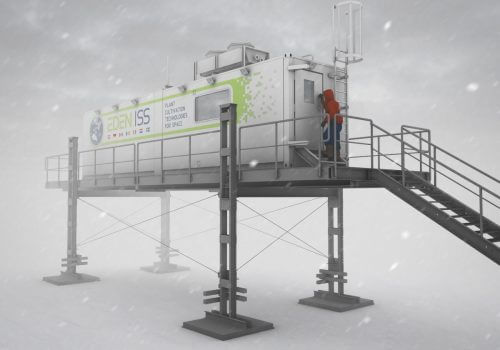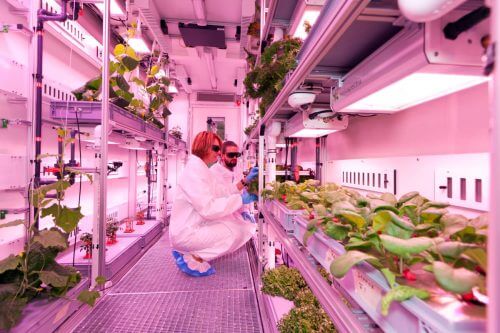A new and sophisticated food incubator has recently started operating in the frozen southern continent. This project should allow one day to develop agriculture in space, and along the way also improve the way we grow fruits and vegetables in slightly warmer places on Earth

By Alina Fishman, Angle, Science and Environment News Agency
In the movie "Saving Mark Watney" Matt Damon plays an astronaut who was abandoned alone on the planet Mars, and survives thanks to his skills as an engineer and botanist, which allow him to produce water for himself and grow potatoes for food in substandard conditions. So it is true that this is a science fiction film, and it is true that human feet have never set foot on the soil of Mars yet, but the idea of growing potatoes in extreme conditions is actually quite non-fictional.
Indeed, these days the Hollywood script takes place in the reality of Antarctica. Mars And Antarctica are of course two very different places from each other, but both have extreme and harsh environmental conditions, which are very hostile to humans. Similar average and freezing temperatures prevail (minus 60 degrees on Mars and minus 20 to 45 degrees in the interior of the Antarctic continent) and both are isolated and far from any human settlement. And like in the movie, also in Antarctica there are teams of researchers who sit in isolated research stations, and perform various experiments and studies.
The largest desert in the world
The continent of Antarctica is the coldest place in the world, with Average temperature of about 50 degrees Celsius below zero Near the South Pole, therefore it has no permanent residents. However, throughout the continent there are research stations, most of which are staffed only in the summer. In fact, Antarctica has only two seasons: winter and summer. In the summer (November-March) the sun does not set, while in the winter (April-October) it sets.
Antarctica is also in fact The largest desert in the world, because the average amount of precipitation is less than 200 millimeters per year. The combination between very low temperatures, soil poor in minerals, lack of moisture and sunlight does not allow the development of plants.
The scientists who arrive in Antarctica have to spend many months without a supply of fresh fruits and vegetables. The relentless winters there do not allow food to be grown there, so fresh supplies are sent there from a long way across the sea, several times a year. The only way to transport food to the research station is by plane or ship. And even so, most of the food that arrives is dried or frozen. But luckily for the researchers on the frozen continent, it seems that all this is about to change.
Grow vegetables in the air
Engineers at the German Space Research Center have developed High-tech greenhouse on behalf of Eden-ISS, where a variety of edible plants can be grown, even when the temperatures outside are 70 degrees below zero. In July 2017, they managed to grow the first cucumber in the greenhouse, which weighed 96 grams and was 14 centimeters long. After this success, the new greenhouse was sent to its destination at the research station Neumayer III In Antarctica, where the researchers will grow 50-30 different species of plants such as lettuce, tomatoes, peppers, cucumbers, radishes, strawberries, and different types of herbs, which will diversify the diet of the station staff.
In order to overcome the hostile conditions prevailing in Antarctica, it was decided to grow the crops in a greenhouse using theAeroponics, which allows growing plants without a substrate, with their roots in the air. The plants actually grow on hanging trays, with their root system directly exposed to the air, with no soil underneath. By using a sprinkler system, the plants receive every few minutes a rich spray of a mixture of minerals and fertilizers essential for their development, which naturally originate in the soil, directly on the roots.
42 LED lamps that emit light in red and blue wavelengths, which give the greenhouse a kind of oval glow, are the source of light for the plants in the greenhouse. Light at these wavelengths is optimally suited to require plants in the process of photosynthesis, where the plant uses light energy to turn carbon dioxide into sugars - the plant's building blocks for growth and growth while producing oxygen. Also, to ensure that the photosynthesis process in the plants will be optimal, a system works to enrich the air inside the greenhouse with additional carbon dioxide.

One of the main problems in agriculture in the Antarctic is, of course, dealing with the extreme weather. To ensure that the temperature inside the greenhouse will always be optimal for growing plants, in contrast to the temperatures prevailing outside, the new greenhouse has a climate control system, which ensures that the temperature prevailing inside will always be in the range between 25-20 degrees Celsius. This range is ideal for supporting the plant's physiological processes.
From the ice to the city and space
the greenhouseEden-ISS, is unlike any other greenhouse in use today. The main reason for this is that it is based on a closed system, where all the resources needed to grow plants come from within the system itself, including water, oxygen, light, carbon dioxide and minerals. Since the greenhouse is a closed system, there is great importance in recycling the water within the system. To this end, the humidity level inside the greenhouse is constantly controlled and monitored. The water vapor in the air inside the greenhouse undergoes a condensation process in which the water turns back from a gas to a liquid, thus enabling the reuse of water, which as mentioned is limited in the system.
God-Eden-ISS It was not only developed to improve the nutrition of the research teams sitting in Antarctica, but it was designed to produce technology that would allow the cultivation of fresh fruits and vegetables outside the borders of the planet. The researchers hope that if it is indeed possible to grow fruits and vegetables in this greenhouse, even when it is 70 degrees below zero outside, it can be used to help astronauts grow food in space.
It is understood that the researchers do not forget the earth and its inhabitants either. The knowledge that will be gathered during the mission in Antarctica will help to improve the efficiency of the use of resources in controlled agricultural systems, the technologies to improve the quality and safety of food and the growing conditions of edible plants in vertical farms inside buildings in cities - what is known as urban farms. And so, the food that will feed the researchers of the isolated stations at the southern end of the world could eventually benefit us as well.

One response
The scientists claim that in the distant past Antarctica was much less cold and palm trees even grew there (!).